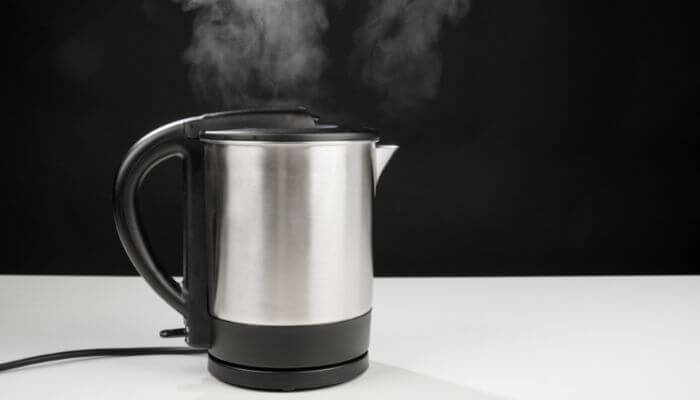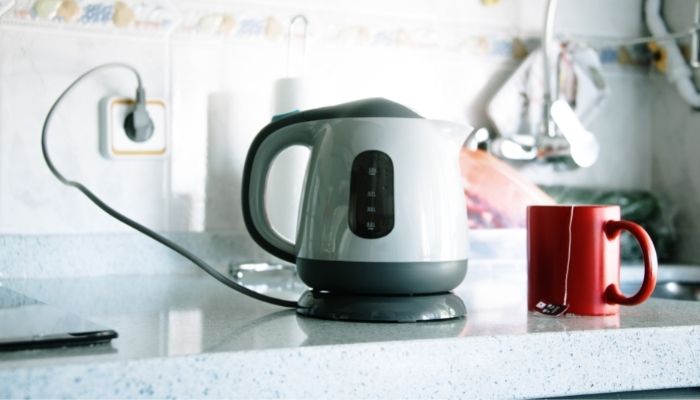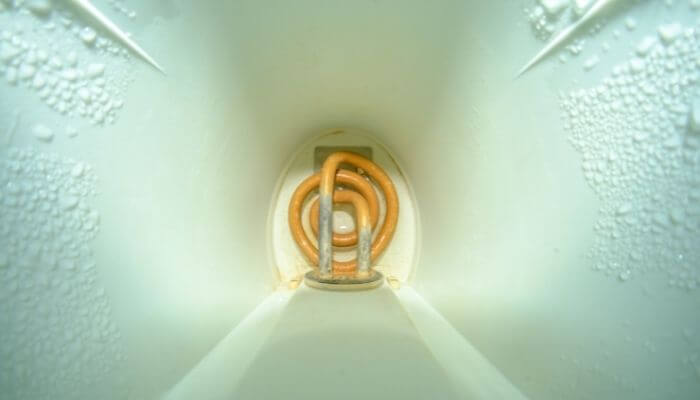Electric kettles are convenient, yet often very noisy.
The speed at which electric kettles heat up causes several things to happen which can make your kettle particularly noisy.
Thankfully there are a number of things you can do to reduce the sound including using a tea cozy, using rubberized undercoating spray, removing limescale buildup and more.

How Loud is an Electric Kettle?
A consumer watchdog group tested the decibel (dB) output of several popular models of electric kettles.
The quietest tested was 79 dB, and the loudest was 95 dB.
The quietest kettle normally has safety features like auto shut-off feature or boil-dry protection where it will not boil when there is no water or water levels fall to a certain height of the water gauge.
For comparison, normal human speech is only around 60 to 65 dB, so the noise could certainly disrupt a conversation.
Vacuum cleaners put out around 83 dB, lawnmowers produce about 90 dB, and drill makes about 90 to 95 dB.
Extended or repeated exposure to sounds at or above 85 dB can cause hearing loss, so be careful if you drink a lot of tea.
So How Can You Quieten an Electric Kettle?
If your electric kettle is too loud, here are some things you can do to reduce the noise:
1. Buy a Quiet Kettle
Not all standard kettles are the same.
Some are designed to have a lower noise level by having a larger electric heating element in them.
This disperses the heat more evenly, reducing the drastic temperature difference between the pocket of expanded water and the cold water in the kettle, thereby reducing the amount of cavitation, and, in turn, the amount of noise created.
2. Use a Tea Cosy
Tea cozies are essentially a little blanket that is shaped to fit over your kettle.
This not only keeps the water in your pot hotter for a longer amount of time, but it can also dampen the noise of your electric kettle working.
Tea cozies are often made of wool or similar materials that both reduce the transfer of heat and absorbs the energy of sound waves, which keep your kettle quiet.
They also come in all kinds of patterns and designs, so they can add a bit of color or flair to your kitchen.
3. Rubberize the Underside of the Kettle
Rubberized undercoating spray was developed to protect the underside of cars from rust and to limit the amount of noise from the road.
It is available on Amazon, so you can use it on your electric kettle if you want.
It’s essentially a permanent tea cozy in that it offers both heat and soundproofing, but the rubber material holds up under repeated heating to ensure you have silent kettles the whole day long.
4. Put the Electric Kettle on extra padding
If your kettle isn’t as loud when you pick it up, it could be that the noise is being amplified by reflecting off the surface the kettle is resting on.
It’s also possible the tribulation of the water is shaking the entire kettle, and more noise is being produced as it rattles against the countertop.
By placing the electric kettle on extra padding like a rubber mat, you can prevent any vibration noise and stop the reflection of noise.
Some sound deadening mats can even absorb the noise of the water cavitating.
5. Remove Limescale Buildup Within the Kettle
When you heat water it evaporates, but any minerals in the water such as calcium, do not become gaseous.
They instead remain, super-concentrated, in the remaining liquid water.
In hard-to-reach places where water repeatedly heats and solidifies, such as around your electric kettle’s heating element, a buildup of calcium carbonate, also known as limestone can develop.
When in contact with water, it can cause it to have a metallic taste.
If your electric kettle has gotten louder over time, it could be because the heating element has been coated with limestone, reducing the amount of surface area available to heat the water, further increasing the amount of cavitation (and noise) in the water when heating.
Limescale is very hard to remove by scrubbing alone, but it can be removed with various chemical solutions.
To remove limestone buildup, try filling the electric kettle with a solution of either:
- equal parts of vinegar rinse and water
- one teaspoon of citric acid rinse to 100ml of water
- equal parts of lime or lemon juice rinse and water
Let the solution soak for an hour.
Then bring the solution to a boil to fully dissolve the limestone.
Let the solution cool, then pour it out and thoroughly rinse the kettle.
You can also wash it with dish soap.
6. Switch To a Stainless Steel or Glass Kettle
If you have tried all the ways above and it does not make your electric kettle quieter, you may like to consider changing to stainless steel kettle or retro kettles with a lower decibel level. I recommend those which have a double-wall design, cool-touch exterior and non-slip handles.
How an Electric Kettle Heats Water?

To understand how an electric kettle works, let’s first consider how a traditional stainless steel kettle works.
An average kettle is filled with water and placed on a stove.
The stove’s burner, either gas or electric, heats the bottom (and sides) of the kettle. The heat is further transferred into the water, increasing the water temperature until it boils.
A modern design electric kettle condenses this set up so that the stovetop burner is replaced by an electric heating coil inside the base of the kettle.
While this makes the electric kettle quick and convenient, it does create the noise problem many people complain about.
As water heats, it expands. If it gets hot enough, it expands so much that it becomes a gas- steam.
Whether the water fully becomes a gas bubble or is just a pocket of hot, expanded water, the hot water has lower density than the surrounding colder water and will float to the surface.
Because water is heated at the bottom of the kettle (as heat is transferred from the heating element or the stove burner by way of the pot), the hot water has to pass through all of the cold water on its way to the surface.
As the boiling water travels up through the kettle, some of its heat is transferred to the cold water surrounding it.
Eventually, the hot water cools down so much that it is no longer a gas (or expanded, hot water).

When the water shrinks back to its smaller size, it creates a condition called cavitation, in which a pocket of empty space is created within the water.
This pocket is quickly filled by the surrounding water rushing in, creating a loud noise in a similar way to how closing cavitation of air caused by a bolt of lightning results in the “crack” of thunder.
You’ll notice that the sound lessens or stops before the kettle begins boiling.
This is because the more this process repeats, the more heat has been transferred to the rest of the water. When passing up through warmer water, less heat is lost, and the pocket of steam is able to make it to the surface.
The water is now boiling.
Electric kettles produce more noise than retro design traditional kettles because their heating elements are naturally smaller. Instead of heat transfer into the water along the entire bottom (and to a lesser extent, the walls) of the traditional kettle, only the water surrounding the heating coil itself heats up.
This creates a greater temperature difference between the hot pocket of steam and the surrounding cold water, resulting in a more pronounced cavitation and louder “knocking”.
As an Amazon Associate I may earn a small fee from qualifying purchases at no extra cost to you. This helps us run the site, so thanks for your support!



